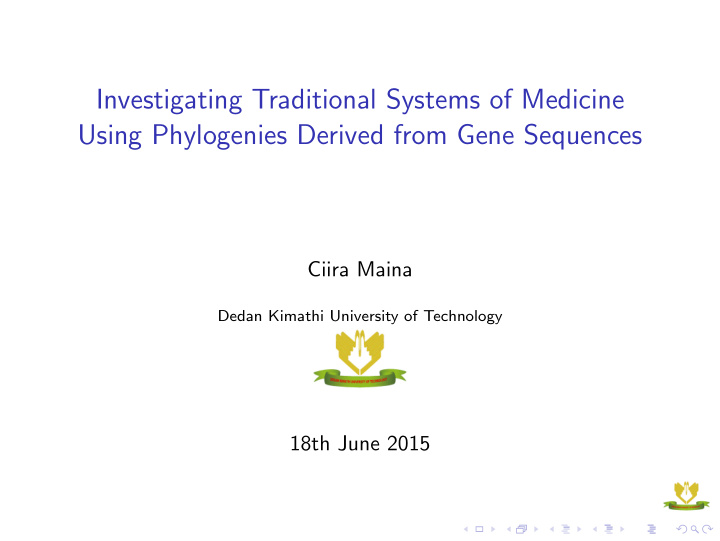



Investigating Traditional Systems of Medicine Using Phylogenies Derived from Gene Sequences Ciira Maina Dedan Kimathi University of Technology 18th June 2015
Introduction ◮ Traditional systems of medicine have been a source of several live saving medicines for centuries ◮ Modern phamaceutical companies have also sought to exploit active compound in traditional medicines. ◮ A recent success story is the use Artemisia annua of to treat malaria
Introduction ◮ There are various approaches to discovering active drug compounds from traditional medicine ◮ Collectively we refer to this as bioprospecting ◮ The methods include: ◮ Chemical testing for active compounds. ◮ in vitro testing of plant extracts. ◮ Studies have been performed to determine the antiplasmodial action of several plant extracts to develop anti-malaria drugs ◮ Clarkson et al. tested 139 plant extracts for antiplasmodial action and found 23 highly active extracts 1 . 1 Clarkson, C. et al (2004). In vitro antiplasmodial activity of medicinal plants native to or naturalised in South Africa. Journal of ethnopharmacology, 92(2), 177-191.
Modern Approach to Traditional Medicine ◮ Studies suggest the medicinal properties are not randomly distributed among plants 2 ◮ Certain plants groups are more likely to have bioactive compounds than others ◮ This suggests that phylogenetics studies of plant species can help in drug discovery 2 Saslis-Lagoudakis CH, et al. (2012) Phylogenies reveal predictive power of traditional medicine in bioprospecting. Proceedings of the National Academy of Sciences 109: 15835-15840.
Modern Approach to Traditional Medicine ◮ It is costly to randomly test for bioactivity ◮ A more targeted approach is necessary to find candidates with a high potential of bioactivity ◮ Combining traditional knowledge of medicinal plants and phylogenetic analysis can uncover neglected species of high promise.
What is a phylogeny? Source: mikethechickenvet.wordpress.com
The Idea ◮ Build phylogenies using DNA sequences ◮ Use knowledge of traditional use of the plants for medicinal purposes ◮ Discover any nodes in the phylogeny that are over represented for medicinal plants-hot nodes ◮ Discover potential bioscreening targets
The Idea Evenly distributed Hot Node
Methods ◮ We need information on the flora in a given region ◮ Lists of species used to treat various diseases in the region ◮ Access to gene sequence data of gene markers that can resolve plant phylogeny ◮ Methods to build phylogenies from sequence data ◮ Methods to investigate community structure of the phylogenies.
Study of TM in Central Kenya ◮ Pioneering work by Muruga Gachathi on a Kikuyu botanical dictionary provides a valuable starting point 3 ◮ This botanical dictionary contains information on over 400 plants. ◮ Those with medicinal uses have also been classified in this text with details about the plant part used. 3 Gachathi M (2007) Kikuyu botanical dictionary: a guide to plant names, uses and cultural values. Tropical Botany.
Gene sequence data: Biology 101 ◮ Cells of living organisms contain genomes which have genes ◮ For normal function, a cell must produce certain enzymes and proteins ◮ Genes code for these proteins ◮ A gene consists of a sequence of Bases: ◮ A,T,G,C Image courtesy of the National Human Genome Research Institute’s
Gene sequence data: Gene Markers ◮ Gene markers are used to create phylogenies ◮ They are sequences of DNA which contain enough variability but are present in most organisims ◮ For most plants the genes rbcL and matK are good gene markers ◮ To determine the gene sequence for a particular gene for a given organism, the genome is sequenced from DNA material extracted from the organism
Gene sequence data: Gene Markers ◮ Consider the cabbage (Mboga), Brassica oleracea var. capitata ◮ The sequence for the rbcL is available from the National Center for Biotechnology Information (NCBI) database
Gene sequence data: Gene Markers
Gene sequence data: Gene Markers
Building Phylogenetic Trees from Gene sequence data ◮ Given gene sequences of gene markers from organisms of interest we can construct phylogenetic trees ◮ We download these sequences for the NCBI database http://www.ncbi.nlm.nih.gov/genbank/ ◮ Scripts can do this automatically ◮ The first step is to align the sequences using multiple sequence alignment software ◮ In this work we use the ClustalW2 program from the European Bioinformatics Institute
Building Phylogenetic Trees from Gene sequence data ◮ With aligned sequences we can then build phylogenies using agglomerative clustering techniques 5 2.0 4 1.5 5 3 3 4 1.0 2 2 0 0.5 1 1 0 0.0 0 1 2 3 4 5 4 3 5 1 0 2
Building Phylogenetic Trees from Gene sequence data ◮ Or we can use probabilistic methods to infer the phylogeny form the gene sequences ◮ We can use maximum likelihood methods RAxML as well as other open source programs such as GARLI, PHYML ◮ Bayesian approaches MrBayes
Investigating community structure ◮ Once we have a phylogenetic hypothesis we can explore the community structure 4 ◮ If we have a group of plants that treat a particular disease we can explore their distribution in the phylogenetic tree ◮ Compute statistics such as Mean Phylogenetic Distance ◮ See whether the MND is significantly smaller than would be expected at random ◮ Use this information to discover hot nodes and potential candidates, we use picante an R implementation of Phylocom 4 Webb CO, et al. (2008) Phylocom: software for the analysis of phylogenetic community structure and trait evolution. Bioinformatics 24: 2098-2100
Results ◮ We use the matK gene ◮ Phylogenetic tree of approximately 130 taxa obtained using RAxML
Community structure for Headache, cold and fever ◮ Observed MPD 0 . 97, Average MPD 2 . 43, p-value 0 . 062
Community structure for Cough, chest and pneumonia ◮ Observed MPD 0 . 96, Average MPD 2 . 43, p-value 0 . 039
Conclusions and future directions ◮ We have explored using phylogenetic knowledge to investigate Traditional medicine ◮ Preliminary results are encouraging ◮ Explore Bayesian approaches to phylogenetic tree construction. ◮ Add more taxa and explore other gene markers ◮ Collaboration with chemists, botanists and herbalists
Thank You
Recommend
More recommend